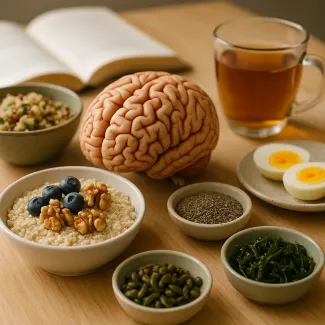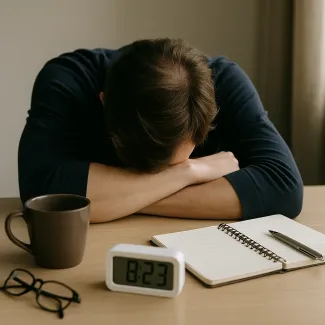Understanding the Science Behind Sleep Data and Nightly Recovery
Why your sleep tracker is showing more than just hours slept
Modern sleep tracking devices are changing the way we understand rest, recovery, and overall well-being. But having access to sleep data is only helpful if you know how to read it—and more importantly, how to use it to improve your sleep. Many people look at their sleep tracker and see numbers like sleep score, deep sleep, or heart rate variability without knowing what they mean. By learning to interpret this data, you can turn raw information into powerful tools for better restorative sleep, better energy, and improved mental and physical health.
The evolution of sleep tracking: from paper logs to wearable intelligence
Sleep tracking used to involve journals and guesswork. Today, wearable trackers, smart rings, and even smartphone apps collect thousands of data points every night. These tools go beyond counting sleep hours—they monitor sleep stages, movement, heart rate, respiratory rate, temperature changes, and oxygen saturation. Some even detect snoring or breathing irregularities. This opens up a more detailed look into your sleep quality than ever before.
Key sleep metrics and what they reveal about your nights
Understanding the terminology of your sleep data is the first step. Here's a closer look at what each sleep metric usually represents:
Sleep stages: light, deep, and REM
Your sleep is divided into three main stages:
- Light sleep (N1 and N2) helps with memory consolidation and nervous system recovery. It makes up about 50% of the night.
- Deep sleep (N3) is where the most intense physical recovery occurs. Growth hormone is released, and the immune system gets a boost.
- REM sleep is vital for emotional processing, cognitive restoration, and dreaming. It's particularly important for mental sharpness and learning.
A healthy sleep architecture should contain all three stages in balance, with enough time in deep and REM sleep to feel refreshed.
Sleep duration vs. sleep quality
People often focus on how long they sleep, but sleep quality is just as important. Fragmented sleep—even if it's long—leaves you groggy. Trackers can detect sleep interruptions, which usually go unnoticed but can disrupt the body’s natural cycles.
Sleep onset latency and efficiency
If your tracker shows long sleep onset latency (the time it takes to fall asleep), it might signal overstimulation before bed. Sleep efficiency, the percentage of time you spend asleep while in bed, is another indicator. A lower number suggests restlessness, while a higher one indicates better sleep consolidation.
Heart rate variability (HRV) and recovery
HRV measures the variation in time between heartbeats. It reflects how well your autonomic nervous system is functioning. Higher HRV during sleep generally signals good recovery, while low HRV may indicate stress, overtraining, or poor sleep quality.
Resting heart rate and respiratory rate
A lower resting heart rate during sleep is a sign that the body is relaxed. A stable respiratory rate also reflects deep, undisturbed sleep. Sudden increases can indicate illness, stress, or sleep disturbances.
Temperature deviations and sleep stability
Some wearables measure your skin temperature at night. Increased body temperature can indicate hormonal shifts, inflammation, or menstrual cycle changes. Temperature spikes may correlate with poor recovery, especially when paired with low deep sleep.
How to identify patterns and trends in your sleep data
One night’s data is just a snapshot. Real insight comes from identifying patterns over time. Are your REM sleep levels consistently low? Does your HRV dip after late meals or evening workouts? Do you sleep better on weekends or after socializing less? Using your tracker’s weekly or monthly views helps reveal these trends.
By recognizing triggers that affect your sleep quality, you can adjust your lifestyle accordingly. Look for recurring dips in sleep efficiency or trends in elevated heart rate to guide changes in your routine.
Improving sleep based on your personal metrics
Once you understand the data, it's time to take action. Use your sleep tracker as a feedback tool. Here’s how to translate metrics into change:
Tweak your bedtime routine to reduce latency
If you're taking too long to fall asleep, build a wind-down routine. That might include blue light reduction, reading, gentle stretching, or meditation. Avoid stimulants and screen time at least 60 minutes before bed.
Adjust sleep schedule for more deep and REM sleep
Deep sleep is most abundant earlier in the night, while REM sleep peaks in the morning. Going to bed and waking up at the same time daily supports your natural circadian rhythm. Even slight shifts in timing can improve your sleep stage distribution.
Align diet and exercise to support recovery
Eating heavy meals close to bedtime, drinking alcohol, or exercising late can reduce HRV and increase resting heart rate. Instead, plan intense workouts earlier in the day and avoid caffeine after 2 p.m. Try foods that support melatonin production, such as cherries, almonds, or warm milk.
Improve bedroom environment to minimize disturbances
Noise, light, and room temperature have a major impact on sleep efficiency and the length of deep sleep. Aim for a cool (around 18–20°C), quiet, and dark bedroom. Use blackout curtains, white noise machines, or a weighted blanket to create a more consistent sleep environment.
What your sleep score really means
Many trackers assign a sleep score—but it's more than just a number. These scores are based on duration, sleep stages, interruptions, HRV, and other metrics. A high score doesn’t always mean high energy if it lacks alignment with how you feel. Trust your body and use the score as context, not judgment.
Also note that occasional bad nights are normal. It's the 7-day average that gives a more meaningful view of your overall rest.
When to worry about your sleep data
Sleep tracking is not diagnostic, but consistent red flags are worth attention. These may include:
- Chronic low HRV
- Frequent awakenings
- Persistent low REM sleep
- High resting heart rate without exercise
- Irregular respiratory rate
Such trends could signal issues like chronic stress, sleep apnea, or overtraining. In such cases, consider adjusting lifestyle habits or consulting a health professional.
Special considerations: women’s health and hormonal impact
Women may notice significant changes in sleep quality, HRV, and temperature throughout the menstrual cycle, during perimenopause, or under the influence of hormonal contraceptives. Understanding these fluctuations can help women tailor their routines more precisely for better recovery and emotional balance.
The role of mental health in sleep tracking
Stress, anxiety, and mood disorders directly influence sleep latency, fragmentation, and REM duration. Trackers may pick up on these patterns before you consciously notice them. A recurring drop in HRV paired with fragmented sleep often reflects unresolved mental tension.
Incorporating stress-reduction practices like breathwork, evening journaling, or progressive muscle relaxation can improve your emotional resilience and sleep scores over time.
Using sleep tracking for jet lag and shift work
People who travel often or work night shifts benefit especially from tracking their recovery. Monitoring circadian rhythm disruption, heart rate trends, and sleep architecture can guide when to adjust sleep windows, use melatonin supplements, or employ light therapy.
Over time, your device can help you understand how long your body takes to recover from time zone shifts and when you’re most vulnerable to fatigue or impaired focus.
Sleep tracking myths and misconceptions
Many users fall into common traps when reading sleep data:
- Believing more sleep is always better (quality matters more than quantity)
- Obsessing over daily scores and losing sleep due to stress from metrics
- Assuming the device is 100% accurate—sleep trackers are estimations, not medical tools
- Thinking a perfect score equals perfect health
Sleep data is only helpful when interpreted in context. A single bad night doesn’t define your health. Look at the big picture.
Personalizing sleep tracking to your lifestyle
Sleep patterns vary significantly between individuals. Night owls, early risers, highly active people, and those with chronic conditions may all have different sleep profiles. Use your tracker as a tool for self-optimization, not comparison.
You may discover you need more recovery days, lighter meals, earlier sleep, or less screen time than others. That’s the power of personalized data—it reveals your own rhythms and needs.
What to do when sleep data conflicts with how you feel
Sometimes you’ll feel great after a night your tracker says was poor—or vice versa. This is common. Data is just one part of the picture. Subjective experience matters too. Use both sources of insight to create a sleep strategy that works for your body.
If you consistently feel rested despite “low” scores, focus on what’s working and keep observing. If you feel tired despite high metrics, explore lifestyle stressors or environmental triggers.
Integrating sleep tracking into your long-term wellness goals
The ultimate goal isn’t just to get better scores. It’s to use data to feel more energized, focused, emotionally stable, and resilient in daily life. Regular sleep tracking empowers you to notice subtle changes, stay ahead of burnout, and optimize for peak performance across all areas of life.
With time, your data reveals how your body responds to everything—from new routines and supplements to stress, hydration, or travel. That level of feedback can be a game-changer for anyone serious about their health.





